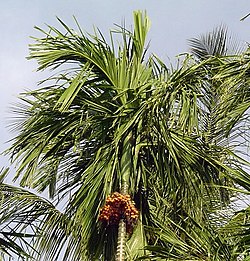Areca catechu
Areca catechu is a species of palm which grows in much of the tropical Pacific, Asia, and parts of east Africa. The palm is believed to have originated in the Philippines,[1] but is widespread in cultivation and is considered naturalized in southern China (Guangxi, Hainan, Yunnan), Taiwan, India, Bangladesh, the Maldives, Sri Lanka, Cambodia, Laos, Thailand, Vietnam, Malaysia, Indonesia, New Guinea, many of the islands in the Pacific Ocean, and also in the West Indies.[2][3][4]
| Areca catechu | |
|---|---|

| |
| Fruiting specimen | |
| Scientific classification | |
| : | [[Template:Taxonomy/Areca]] |
| Species: | Template:Taxonomy/ArecaA. catechu
|
| Binomial name | |
| Template:Taxonomy/ArecaAreca catechu | |
| Synonyms[2] | |
| |
Common names in English include areca palm, areca nut palm, betel palm, betel nut palm, Indian nut, Pinang palm and catechu.[1] In English this palm is called the betel tree because its fruit, the areca nut, is often chewed along with the betel leaf, a leaf from a vine of the family Piperaceae.
GrowthEdit
Areca catechu is a medium-sized palm tree, growing straight to 20 m (66 ft) tall, with a trunk 10–15 cm (4–6 in) in diameter. The leaves are 1.5–2 m (4.9–6.6 ft) long, pinnate, with numerous, crowded leaflets.
CharacteristicsEdit
Areca catechu is grown for its commercially important seed crop, the areca nut.
The cities of Tanjung Pinang, Pangkal Pinang in Indonesia, the Indonesian province of Jambi (jambi or jambe is areca in Javanese, Sundanese, Balinese, and Old Malay), Penang Island, off the west coast of Peninsular Malaysia, Fua Mulaku in the Maldives, Guwahati in Assam, and coastal areas of Kerala and Karnataka in India, are some of the places named after a local name for areca nut. Actually, there are numerous city and areal names in Indonesia and Malaysia using the words pinang or jambe. This shows how important areca nut is in the Austronesian civilization, especially in the modern day Indonesia or Malaysia.
Chemical compositionEdit
The seed contains alkaloids such as arecaidine and arecoline, which, when chewed, are intoxicating and slightly addictive. Areca palms are grown in Bangladesh, India, Indonesia, Malaysia, Taiwan and many other Asian countries for their seeds.
The seed also contains condensed tannins (procyanidins) called arecatannins[5] which are carcinogenic.
UsesEdit
The areca nut is also popular for chewing throughout some Asian countries, such as China, Taiwan, Vietnam, the Philippines, Malaysia, Myanmar, and India and the Pacific Islands, notably Papua New Guinea, where it is very popular. Chewing areca nut is quite popular among working classes in Taiwan. The nut itself can be addictive and has direct link to oral cancers.[6][7] Areca nuts in Taiwan will usually contain artificial additives such as limestone powder. The extract of Areca catechu may be addictive.[8]
The areca palm is also used as an interior landscaping species. It is often used in large indoor areas such as malls and hotels. It will not fruit or reach full size if grown in this way. Indoors, it is a slow growing, low water, high light plant that is sensitive to spider mites and occasionally mealybugs.
In India the dry, fallen leaves are collected and hot-pressed into disposable palm leaf plates and bowls.[9]
GalleryEdit
ReferencesEdit
- ↑ 1.0 1.1 1.2 [{{#property:P1421|}} "{{#Property:P225}}"]. Germplasm Resources Information Network (GRIN). Agricultural Research Service (ARS), United States Department of Agriculture (USDA). Retrieved 2008-03-02.
{{citation}}: Check|url=value (help) - ↑ 2.0 2.1 Kew World Checklist of Selected Plant Families
- ↑ Jones, D. (2001), Palms Throughout The World, Reed New Holland, Australia.
- ↑ Heatubun, C.D., Dransfield, J., Flynn, T., Tjitrosoedirdjo, S.S., Mogea, J.P. & Baker, W.J. (2012). A monograph of the betel nut palms (Areca: Arecaceae) of East Malesia. Botanical Journal of the Linnean Society 168: 147-173.
- ↑ Kusumoto, Ines Tomoco; Nakabayashi, Takeshi; Kida, Hiroaki; Miyashiro, Hirotsugu; Hattori, Masao; Namba, Tsuneo; Shimotohno, Kunitada (1995). "Screening of various plant extracts used in ayurvedic medicine for inhibitory effects on human immunodeficiency virus type 1 (HIV-1) protease". Phytotherapy Research. 9 (3): 180–184. doi:10.1002/ptr.2650090305. S2CID 84577539.
- ↑ Thomas and MacLennan (1992). "Slaked lime and betel nut cancer in Papua New Guinea". The Lancet. 340 (8819): 577–578. doi:10.1016/0140-6736(92)92109-S. PMID 1355157. S2CID 34296427.
- ↑ Hemantha Amarasinghe (2010). "Betel-quid chewing with or without tobacco is a major risk factor for oral potentially malignant disorders in Sri Lanka: A case-control study". Oral Oncology. 46 (4): 297–301. doi:10.1016/j.oraloncology.2010.01.017. PMID 20189448.
- ↑ Marcello Spinella (2001). The psychopharmacology of herbal medicine: plant drugs that alter mind, brain, and behavior. MIT Press. pp. 233–. ISBN 978-0-262-69265-6. Retrieved 14 October 2011.
- ↑ Palm Leaf Plates Archived 2016-09-16 at the Wayback Machine on the website TheWholeLeafCo.dom; viewed in September 2016